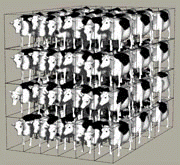Animal Science, Department of

World Congress on Genetics Applied to Livestock Production: 3rd (1986)
Date of this Version
1986
Abstract
At the first and second World Congresses on Genetics Applied to Livestock Production some consideration was given to the definition of breeding objectives in sheep and goats. Having a whole Plenary Session dedicated to the evaluation of breeding objectives at the present Congress is an indication of the greater awareness about the importance of this area in the overall efficiency of breeding programmes. the chances of success of a breeding programme will be enhanced if during its formulation the following five steps are taken in meticulous order: (i) definition of the breeding objective; (ii) choice of selection criteria; (iii) organisation of the performance recording scheme; (iv) use of the information recorded to make selection decisions; and (v) use of the selected individuals. Because the five steps are sequential the success of all other operations intended for the genetic improvement of the population is dependent on the adequate definition of the breeding objective.
JAMES had discussed the general problems of defining breeding objectives in sheep and goats, whereas BRADFORD and MEYER concentrated on practical considerations and described examples for the two species. The purpose of my paper is to highlight the most important points made in those papers and to indicate areas in which future work is likely to yield valuable results. I hope my comments will lead to and stimulate a fruitful discussion.


Comments
Published in 3rd World Congress on Genetics Applied to Livestock Production, edited by Gordon E. Dickerson and Rodger K. Johnson, 4 vols. (Lincoln: University of Nebraska Institute of Agriculture and Natural Resources, 1986). Copyright © 1986 Board of Regents University of Nebraska.